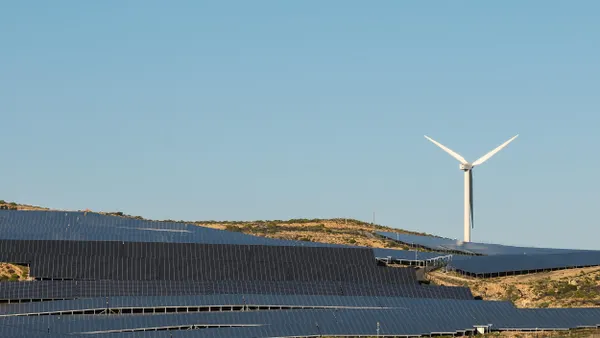Dive Brief:
-
U.S. natural gas production is expected to reach the highest year-over-year increase in 2018, according to the Energy Information Administration’s new Short-term Energy Outlook (STEO).
-
With more gas supplies, the EIA expects gas prices in 2018 and 2019 to sink below 2017 prices, making it a more economic and attractive fuel for power generation.
-
The EIA, an arm of the Department of Energy, expects gas-fired plants to generate 34% of the electricity in the United States in 2019 while coal-fired generation falls to 28%.
Dive Insight:
King Coal fell from its throne in 2016, but it had been slipping since the year before.
According to EIA data, 2016 was the first time gas-fired generation beat out coal-fired generation on an annual basis. Gas beat coal for power generation on a monthly basis for the first time in April 2015.
Gas-fired generation has been on the rise since 2005 as a result of a flood of gas coming from shale formations made accessible by advances in hydraulic fracturing and horizontal drilling.
If natural gas prices fall, as EIA forecasts, the trend away from coal will likely continue. Coal use could spike again as it did during cold weather that blanketed much of the Northeast earlier this month, but such episodes will likely be short lived.
The EIA expects dry natural gas production to average 80.4 Bcf/d in 2018, a 6.9 Bcf/d increase from 2017, and then to increase by an average of 2.6 Bcf/d in 2019.
With all that gas coming on the market, EIA expects prices to fall. The agency estimates Henry Hub spot prices will average $2.88/MMBtu in 2018 and $2.92/MMBtu in 2019. The average price in 2017 was $2.99/MMBtu.
Low gas prices, in turn, will continue to make gas-fired generation more economic than coal generation. The EIA’s STEO sees the U.S. share of utility-scale electricity generation from natural gas rising from 32% in 2017 to 33% in 2018 and 34% in 2019.
Meanwhile, the EIA sees coal’s share of the generation market falling from 30% in 2017 to 29% in 2018 and 28% in 2019.
The trend toward gas is expected to drive more retirements of less competitive generators. The Federal Energy Regulatory Commission expects 20.6 GW of coal-fired capacity to retire by 2020.
Low gas costs kept wholesale power market prices low throughout most of 2017, fueling pricing reform discussions at regional grid operators and driving the DOE to propose a controversial cost recovery package for coal and nuclear plants. Those pricing reform discussions will likely be a focus in the year to come after FERC rejected the DOE plan.
While coal continues to decline, nuclear power’s share of the generation mix will likely remain more stable, staying at 20% in 2017 and 2018 before dropping to 19% in 2019. Non-hydro renewable generation, on the other hand, is expected to continue to gain ground, providing 10% of generation in 2017 and 2018 and rising to almost 11% in 2019.
Despite coal’s declining use for power generation, EIA data shows that coal production increased by 45 million tons in 2017 as a result of a rise in exports. Reuters data attribute the rise in exports to high demand in China and favorable price comparisons — that is, higher prices for overseas coal, which is likely to be temporary.
The EIA’s STEO estimates coal production will decline by another 14 million short tons in 2018 and by 18 million short tons in 2019. That could exacerbate problems for an already troubled industry.
In November, Armstrong Energy of Kentucky became the first U.S. coal company to file for bankruptcy since Donald Trump was elected president. Just over 44% of the coal produced in the United States comes from companies that have declared bankruptcy since 2012, according to SNL data.













